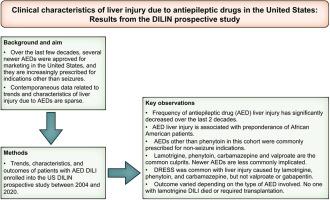Journal of Hepatology ( IF 25.7 ) Pub Date : 2021-12-22 , DOI: 10.1016/j.jhep.2021.12.013 Naga Chalasani 1 , Herbert L Bonkovsky 2 , Jonathan G Stine 3 , Jiezhun Gu 4 , Huiman Barnhart 4 , Elin Jacobsen 5 , Einar Björnsson 5 , Robert J Fontana 6 , David E Kleiner 7 , Jay H Hoofnagle 8 ,

|
Background & Aims
Antiepileptic drugs (AEDs) are a common cause of drug-induced liver injury (DILI). Over the last few decades, several newer AEDs were approved for marketing in the United States, and they are increasingly prescribed for indications other than seizures. Contemporaneous data related to trends and characteristics of AED-related liver injury are sparse.
Methods
We report the trends, characteristics, and outcomes of patients with AED-related DILI enrolled into the DILIN Prospective Study between 2004 and 2020.
Results
Among 1,711 participants with definite, highly likely, or probable DILI, 66 (3.9%) had AED-related DILI (lamotrigine [n = 18], phenytoin [n = 16], carbamazepine [n = 11], valproate [n = 10], gabapentin [n = 4], and others [n = 7]). The frequency of AED-related liver injury significantly decreased during the study period (from 8.5% of cases during 2004-2007 to 2.6% during 2015–2020, p = 0.01). AEDs other than phenytoin were commonly prescribed for non-seizure indications. Compared to non-AEDs, patients with AED-related liver injury were younger (mean age 38.5 vs. 50.1 years-old, p <0.001) and more likely African American (27% vs. 12%, p = 0.008). DRESS was common with liver injury caused by lamotrigine, phenytoin, and carbamazepine, but not valproate or gabapentin. Liver injury severity was moderate to severe in the majority: 5 died, and 3 underwent orthotopic liver transplantation (OLT). No patient with lamotrigine-related DILI, including 13 with hepatocellular jaundice, died or needed OLT, while 3 out of 16 patients (19%) with phenytoin-related DILI either died or required OLT.
Conclusion
The frequency of AED-related liver injury significantly decreased over the last 2 decades in our experience. AED-related liver injury has several distinctive features, including a preponderance in African American patients and those with immunoallergic skin reactions, with outcomes depending on the type of AED involved.
Lay summary
Medications used to treat epilepsy may sometimes cause severe liver injury. However, several new medications have been approved over the last 2 decades and they may not be as toxic to the liver as older antiepileptic medications (AEDs). This study shows that overall liver injury due to AEDs is decreasing, likely due to decreasing use of older AEDs. Liver injury due to AEDs appears to be more common in African Americans and is commonly associated with allergic skin reactions.
中文翻译:

DILIN 前瞻性研究中患者抗癫痫药物肝损伤的临床特征
背景与目标
抗癫痫药物 (AED) 是药物性肝损伤 (DILI) 的常见原因。在过去的几十年里,几种较新的 AED 获准在美国上市,并且越来越多地将它们用于癫痫发作以外的适应症。与 AED 相关肝损伤的趋势和特征相关的同期数据很少。
方法
我们报告了 2004 年至 2020 年间参加 DILIN 前瞻性研究的 AED 相关 DILI 患者的趋势、特征和结果。
结果
在 1,711 名患有明确、极有可能或很可能 DILI 的参与者中,66 名 (3.9%) 患有 AED 相关的 DILI(拉莫三嗪 [n = 18]、苯妥英 [n = 16]、卡马西平 [n = 11]、丙戊酸盐 [n = 10 ]、加巴喷丁 [n = 4] 和其他 [n = 7])。在研究期间,AED 相关肝损伤的频率显着下降(从 2004-2007 年的 8.5% 下降到 2015-2020 年的 2.6%,p = 0.01)。苯妥英以外的 AED 通常用于非癫痫发作适应症。与非 AEDs 相比,AEDs 相关肝损伤患者更年轻(平均年龄 38.5对50.1 岁,p <0.001)并且更可能是非裔美国人(27%对12%,p = 0.008)。DRESS 常见于拉莫三嗪、苯妥英和卡马西平引起的肝损伤,但丙戊酸盐或加巴喷丁不常见。大多数肝损伤严重程度为中度至重度:5 例死亡,3 例接受了原位肝移植 (OLT)。没有拉莫三嗪相关 DILI 患者(包括 13 名肝细胞性黄疸患者)死亡或需要 OLT,而 16 名苯妥英相关 DILI 患者中有 3 名 (19%) 死亡或需要 OLT。
结论
根据我们的经验,过去 20 年 AED 相关肝损伤的发生率显着降低。AED 相关肝损伤有几个显着特征,包括非洲裔美国患者和有免疫过敏性皮肤反应的患者的优势,其结果取决于所涉及的 AED 类型。
外行总结
用于治疗癫痫的药物有时可能会导致严重的肝损伤。然而,在过去的 20 年中,已经批准了几种新药,它们对肝脏的毒性可能不如旧的抗癫痫药 (AED)。这项研究表明,由 AED 引起的总体肝损伤正在减少,这可能是由于老款 AED 的使用减少。AED 引起的肝损伤似乎在非裔美国人中更为常见,并且通常与过敏性皮肤反应有关。


























 京公网安备 11010802027423号
京公网安备 11010802027423号